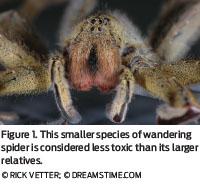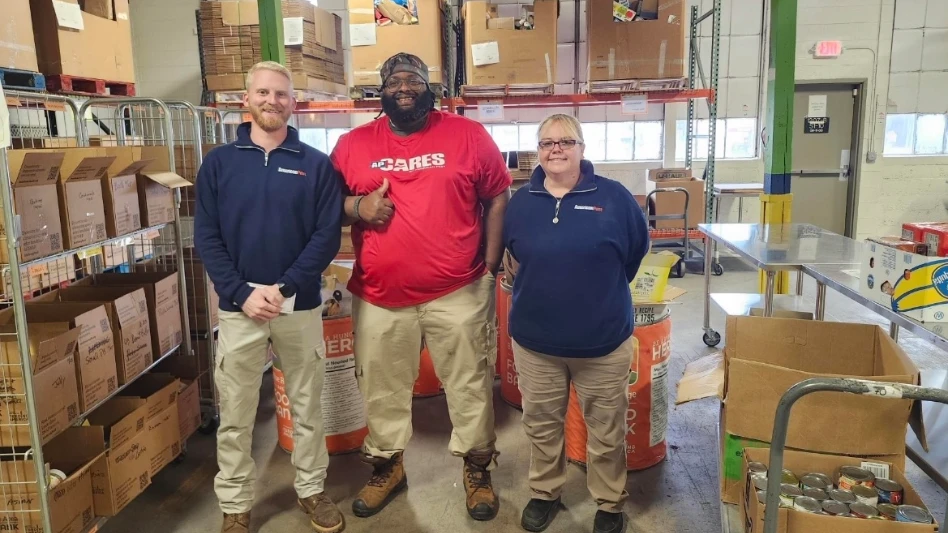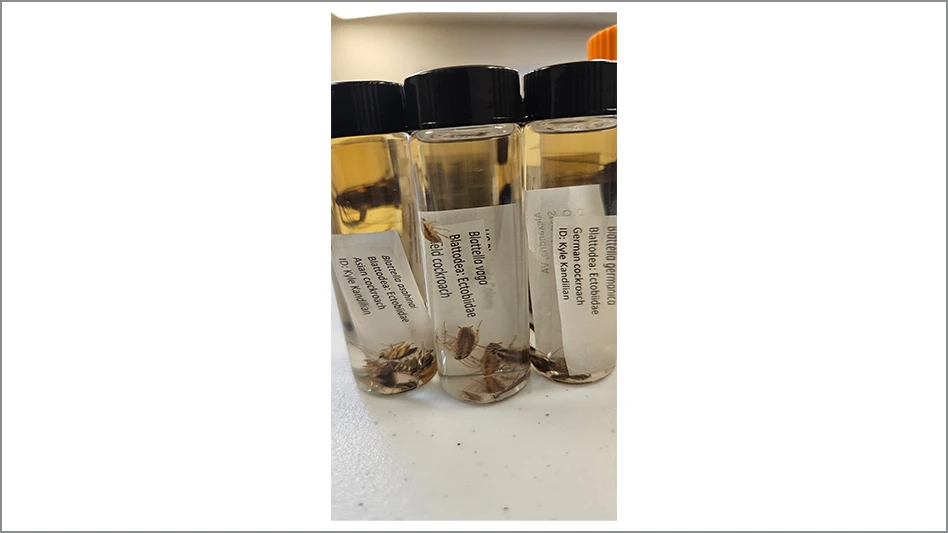 Every so often, a media outlet reports someone finding a spider or an egg sac in a shipment of bananas (or other international cargo). The article typically screams about potentially death-dealing spiders or spiderlings unleashed upon an unsuspecting general public in typical Hollywood 72-point type. The message is almost never one of subtlety or scientific validity. Often people who do not have any arachnological skill other than to surf the Internet (which is full of misinformation) misidentify the harmless spider as being one of a “deadly” species.
Every so often, a media outlet reports someone finding a spider or an egg sac in a shipment of bananas (or other international cargo). The article typically screams about potentially death-dealing spiders or spiderlings unleashed upon an unsuspecting general public in typical Hollywood 72-point type. The message is almost never one of subtlety or scientific validity. Often people who do not have any arachnological skill other than to surf the Internet (which is full of misinformation) misidentify the harmless spider as being one of a “deadly” species.
Being called upon to deal with this episode may be a once-in-a-career event for a pest control professional, however, the hyperbolic reaction of people and the media make this a high-profile situation. Therefore, having the correct information could be invaluable to prevent misidentifications (and the calling of the cavalry). The following article summarizes a recent study published in the Journal of Medical Entomology on spiders brought into North America in international cargo.
Brazilian Wandering Spider.
The spider most discussed in these hyperbolic media and Internet articles is the Brazilian wandering spider, Phoneutria fera. It is presented as a highly toxic monster, resulting in overreaction by the unknowing public. Much of this is due to the fact that because spiders found in bananas are from Central and South America, almost no entomologists and very few arachnologists have, until recently, had any literature on the subject. An “expert” is then pressed for a quick identification from a worried homeowner or grocery store employee.
One of the more commonly intercepted spiders has red hairs on its face. This spider is often misidentified as a Brazilian wandering spider from either Internet images or a children’s spider book. And the spider is described as “deadly” or “poisonous” (although the correct term is actually “toxic”).
In reality, it is extremely unlikely that this species of Brazilian wandering spider would be brought to North America in bananas. First, it lives in the Amazon, far from the Brazilian banana-growing areas in the eastern coastal regions. Second, North America gets 96 percent of its bananas from Central America and northwestern South America (Ecuador, Colombia), not Brazil. Third, Brazil consumes most of its crop domestically so there is little left for export.
In addition, the medically important Brazilian wandering spiders that are highly dangerous are limited to the eastern Brazilian coastal region and despite all the hype and hoopla, are not nearly as “deadly” as they have been made out to be. A report of 422 bites by eastern Brazilian wandering spiders in humans did denote one death in a small child (so they aren’t harmless) but no adults died from a bite and more than 80 percent of the bite victims reported no or minor symptoms. One mitigating factor though is that a smaller species of wandering spider (30 mm in body length compared to 50 mm for the eastern Brazilian species) lives in Ecuador, Colombia and southern Central America and on rare occasion is transported to North America in bananas (Fig. 1). However, this species is considered less toxic than its larger relatives. Reports of bites to banana plantation workers reported no deaths and workers typically missed two or three days before returning to their jobs. So overall, the probability of “deadly Brazilian wandering” spiders showing up in bananas brought to North America is minuscule.
Other Species.
 People are freaked out when they unpack fruit in the store and a long-legged critter comes romping out. And the most common large spider brought into North America on bananas in the 2014 study was the pantropical huntsman spider, Heteropoda venatoria (about 3- to 3½-inch leg span) (Fig. 2).
People are freaked out when they unpack fruit in the store and a long-legged critter comes romping out. And the most common large spider brought into North America on bananas in the 2014 study was the pantropical huntsman spider, Heteropoda venatoria (about 3- to 3½-inch leg span) (Fig. 2).
This creature is found throughout the tropics worldwide including Hawaii, Florida, Taiwan, Hong Kong, Australia, Uganda, Ecuador, etc. It is a harmless spider with long legs rotated to the side so it looks somewhat like a crab. The females are mostly uniformly brown in color whereas the male has a lovely splashing of tan, brown and black markings. However, both sexes have a white “mustache” above the mouthparts and below the eyes.
The other most commonly intercepted spiders are those of the genus Cupiennius. These are large (about 3-inch legspan) and have coloration that allows one to easily identify them. They come from Central America (Guatemala, Costa Rica and Nicaragua). Their bites are of little concern, most becoming asymptomatic within hours.
 The most common species that is intercepted is the redfaced banana spider, C. chiapanensis. This spider has bright red hairs on the upper two-thirds of its chelicerae (the mouthparts that house the fangs) (Fig. 3). This spider is most frequently mistaken for a Brazilian wandering spider. It was only scientifically described in 2006 so arachnologists were not aware of its existence, which is why many misidentifications were made years ago.
The most common species that is intercepted is the redfaced banana spider, C. chiapanensis. This spider has bright red hairs on the upper two-thirds of its chelicerae (the mouthparts that house the fangs) (Fig. 3). This spider is most frequently mistaken for a Brazilian wandering spider. It was only scientifically described in 2006 so arachnologists were not aware of its existence, which is why many misidentifications were made years ago.
However, there are many websites and other sources that mistakenly identify the redfaced banana spider as potentially deadly, causing unwarranted panic and arachnophobia.
A lesser-found species is the spotlegged banana spider, C. getazi, which has black dots on a white background on the underside of the leg segments closest to the body (Fig. 4). Finally, the redlegged banana spider, C. coccineus, is occasionally found in bananas. It has bright red hairs on the underside of the leg segments closest to the body on the first two pair of legs.
Egg Sacs.
 In addition to spiders, occasionally egg sacs deposited on bananas are discovered by supermarket employees or by customers when they unpack the fruit at home. Most of these egg sacs have been smashed into oblivion during transport, however, sometimes, the egg sac contains uncrushed eggs or live spiderlings. Once again, people panic. And predictably, even though non-arachnologists have no experience identifying egg sacs (which are incredibly difficult to identify to species even by arachnologists because there is even less scientific literature on this topic than for spiders), the egg sacs are positively “identified” by amateurs as belonging to the “deadly” Brazilian wandering spider.
In addition to spiders, occasionally egg sacs deposited on bananas are discovered by supermarket employees or by customers when they unpack the fruit at home. Most of these egg sacs have been smashed into oblivion during transport, however, sometimes, the egg sac contains uncrushed eggs or live spiderlings. Once again, people panic. And predictably, even though non-arachnologists have no experience identifying egg sacs (which are incredibly difficult to identify to species even by arachnologists because there is even less scientific literature on this topic than for spiders), the egg sacs are positively “identified” by amateurs as belonging to the “deadly” Brazilian wandering spider.
Of the 20 or so egg sacs that have been submitted to me for identification, almost all were pulverized into flatness and the ones that weren’t had 50 to 200 eggs. The species of wandering spider that has shown up on rare occasion in bananas shipped to North America lays an average of 850 eggs per sac. Therefore, the egg sacs arriving with bananas so far surely are not that of wandering spiders. Attempts to rear the spiderlings to adulthood have failed; these spiderlings look closest in identity to a small species not known to be harmful.
Final Thoughts.
The overall conclusions from the study were:
- Almost all spiders transported to North America in bananas are medically benign.
- Most wandering spider bites are not fatal.
- The species of wandering spider from northwestern South America that is rarely found in bananas is smaller than the dangerous Brazilian species and its bites do not result in death.
- The wandering spiders of medical importance are found in Brazil, which doesn’t export a significant amount of bananas anywhere and possibly none to North America.
- Egg sacs found on bananas are not from wandering spiders but their identity is currently not known.
References
Vetter, R.S. and S. Hillebrecht. 2008. On distinguishing two often-misidentified genera (Cupiennius, Phoneutria) (Araneae: Ctenidae) of large spiders found in Central and South American cargo shipments. American Entomologist 54: 82-87.
Vetter, R. S., R. L. Crawford and D. J. Buckle. 2014. Spiders (Araneae) found in bananas and other international cargo submitted to North American arachnologists for identification. Journal of Medical Entomology 51: 1136-1143.
The author is a retired staff research associate with the University of California, Riverside, and one of the country’s leading authorities on spiders.

Explore the October 2015 Issue
Check out more from this issue and find your next story to read.
Latest from Pest Control Technology
- Thomas Pest Services Opens New Office, Celebrates 15 Years in Business
- Bruno Milanese Reflects on Experiences During Hurricane Katrina
- Envu's Horizon Rewards Program
- New Species Being Discovered Faster Than Ever, Study Finds
- NCPMA Announces David Billingsly as Pest Control Technician's School Keynote Speaker
- Velez Promoted to VP of Operations at Victory Pest Solutions
- Guarantee Pest Control's Gary Blankenship Reflects on 50 Year Pest Control Career
- Happy New Year!





